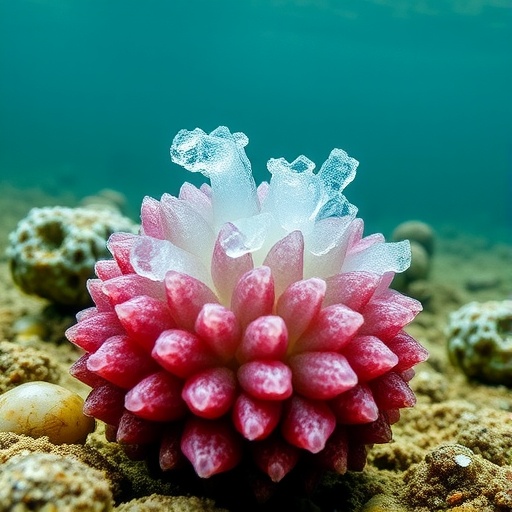Chitosan, a biopolymer derived from chitin, has recently sparked significant interest in environmental science due to its unique ability to influence the bioavailability of heavy metals, particularly cadmium. As global industrialization continues to progress, the challenge of managing toxic heavy metals in our ecosystems has become paramount. The research conducted by Mola Ali Abasiyan, F. Dashbolaghi, and G.R. Mahdavinia sheds light on an innovative approach to addressing this pressing issue, utilizing chitosan cross-linked with κ-carrageenan.
One compelling aspect of this research is the synthesis of a biocompatible polymer network that demonstrates remarkable efficacy in heavy metal sequestering. Chitosan itself is a natural polymer abundant in crustaceans’ shells, and its structure is conducive to cross-linking with other polysaccharides such as κ-carrageenan, which is extracted from red seaweed. The combination of these two biopolymers results in a hydrogel that exhibits superior adsorptive properties when interacting with cadmium ions. The ionic interaction between the heavy metal ions and functional groups present on the polymer backbone fosters a stable anchorage of cadmium, rendering it less bioavailable in environmental contexts.
The necessity of finding viable solutions for cadmium removal is underscored by the heavy metal’s intrinsic properties. Cadmium is known for its nephrotoxic effects and is a carcinogen in humans. It readily accumulates in biological systems, escalating the risks associated with long-term exposure. Consequently, the urgency to develop effective remediation strategies is evident. The study in question posits that the chitosan and κ-carrageenan composite provides a dual-functional platform: not only can it capture cadmium from polluted water bodies, but it can also remediate contaminated soil, making it particularly versatile for environmental applications.
Distinct from conventional methods that often employ synthetic adsorbents, this biopolymer-based approach prioritizes sustainability. The utilization of natural materials not only enhances the eco-friendliness of the process but also minimizes the ecological footprint associated with cadmium removal. Moreover, the biodegradability of both chitosan and κ-carrageenan ensures that after the heavy metals are sequestered, the residual materials can break down naturally, reducing the risk of secondary pollution.
The innovative cross-linking method used in the study aims to improve the mechanical strength and stability of the hydrogels under various environmental conditions. This enhancement is crucial; they must withstand fluctuating temperatures and varying pH levels, which are common in natural bodies of water and soils. The meticulous experimental design described by the researchers includes varying the cross-linking ratios and testing the resultant adsorption capacities, thereby identifying the optimal conditions for cadmium removal.
Quantitative assessments revealed that the hydrogels exhibited impressive cadmium ion removal efficiencies, which were assessed through batch adsorption experiments. By adjusting parameters such as contact time and initial cadmium concentration, the researchers were able to delineate parameters for maximum uptake efficiency. A thorough understanding of these kinetics offers significant implications for scalability and practical application in larger remediation efforts.
One noteworthy consideration of the study is the potential for commercialization of the proposed biopolymer blend. If produced at scale, this new material could be integrated into existing water treatment infrastructures, providing municipalities and industries with an affordable and efficient option for cadmium removal. Chitosan and κ-carrageenan themselves are cost-effective materials, and their combination could lead to a green solution that is both economically viable and accessible, particularly for developing nations grappling with industrial waste management.
Furthermore, there is an aspect of community engagement that could augment the implementation of this technology. Educating local communities about pollution and the potential benefits of active participation in remediation practices could pave the way for grassroots initiatives. By emphasizing the role of biopolymers in environmental stewardship, residents can connect with their local ecosystems and contribute to both sustainable practices and improved health outcomes.
The implications of this research extend beyond cadmium alone; they resonate across a spectrum of heavy metals and pollutants. The fundamental principles that emerge from the polymer cross-linking methodology could inspire further investigation into other problematic contaminants. In particular, modifications could facilitate selective adsorption of various metal ions, thereby enhancing the versatility of biopolymer applications in eco-remediation strategies globally.
Recent findings also emphasize the potential to modify and functionalize the composite materials further, potentially augmenting their binding capacity through chemical or physical treatments. Such exploration could broaden the scope of this technology, enabling researchers to fine-tune the properties of the hydrogels for specific contaminants, including lead, arsenic, and other toxic metals prevalent in industrial effluent.
In summary, the research conducted by Abasiyan and his colleagues marks a significant stride in the quest to mitigate the adverse effects of cadmium and other heavy metals in our environment. By harnessing the natural capabilities of biopolymers like chitosan and κ-carrageenan, the authors present innovative solutions that align with sustainability goals while addressing urgent public health concerns. This ground-breaking study is a testament to the synergy of environmental science and material innovation, inviting further exploration and application of biopolymer technologies in environmental remediation efforts worldwide.
As we move forward, the study serves as a call to action for scientists, engineers, and policymakers alike to recognize the potential of biodegradable materials in combating environmental pollution. It underscores the importance of continued research in this domain, highlighting how interdisciplinary collaboration can lead to innovative solutions for some of today’s most pressing environmental challenges.
In conclusion, the captivating intersection of biopolymer technology and environmental remediation, as demonstrated by this study, encourages a future that harnesses natural processes and materials to restore ecological balance. As the world grapples with heavy metal contaminants, studies like this remind us of the sustainable pathways we can take toward a cleaner, healthier planet.
Subject of Research: Cadmium removal using chitosan cross-linked with κ-carrageenan.
Article Title: Correction to: Chitosan cross-linked with κ-carrageenan to remove cadmium from water and soil systems.
Article References:
Mola Ali Abasiyan, S., Dashbolaghi, F. & Mahdavinia, G.R. Correction to: Chitosan cross-linked with κ-carrageenan to remove cadmium from water and soil systems.
Environ Sci Pollut Res (2025). https://doi.org/10.1007/s11356-025-36959-3
Image Credits: AI Generated
DOI: 10.1007/s11356-025-36959-3
Keywords: chitosan, κ-carrageenan, cadmium removal, environmental science, biopolymers, heavy metal remediation.




